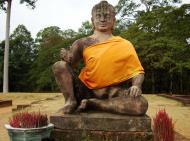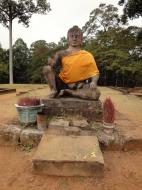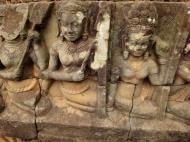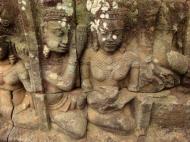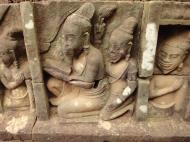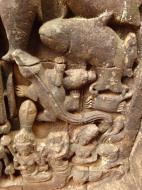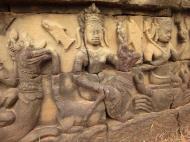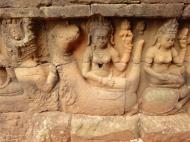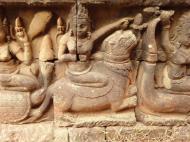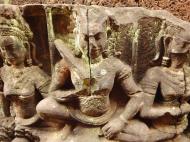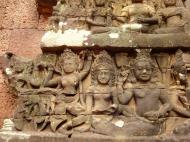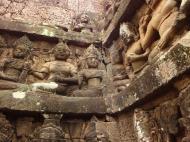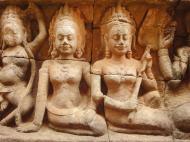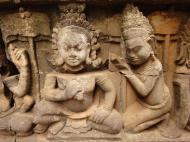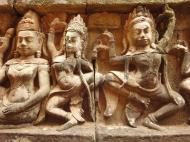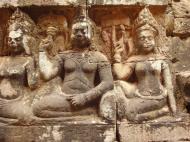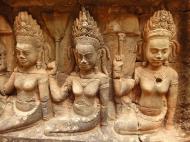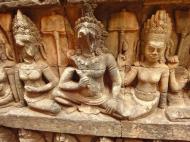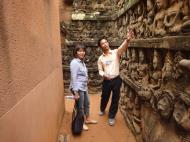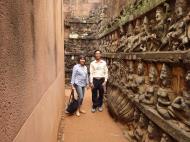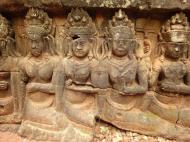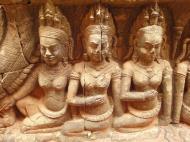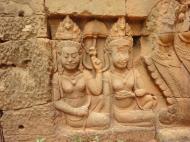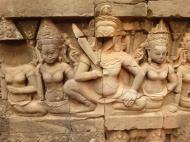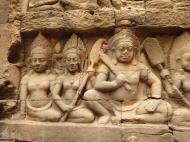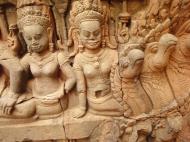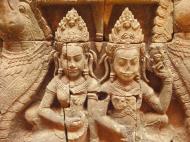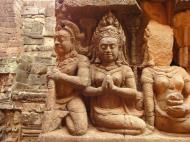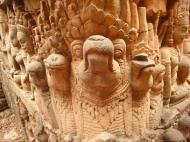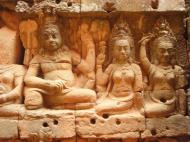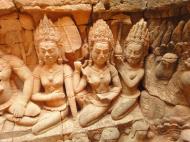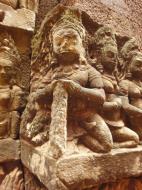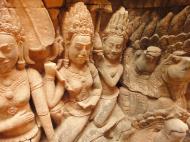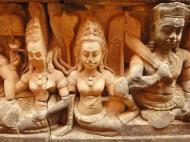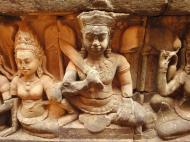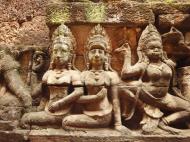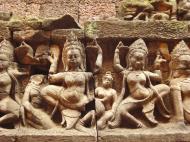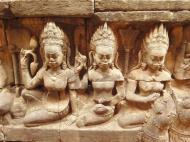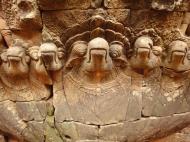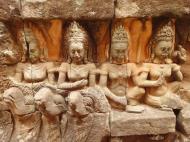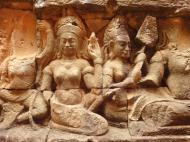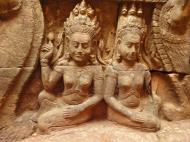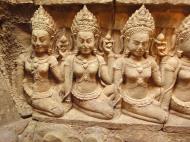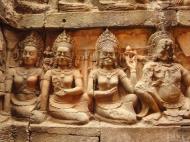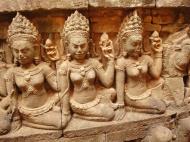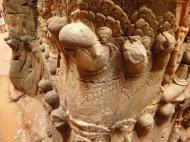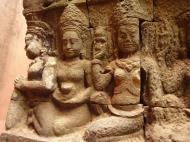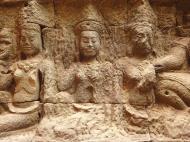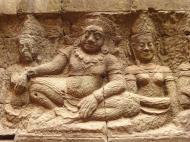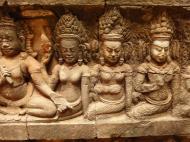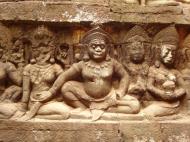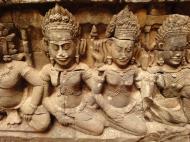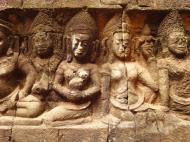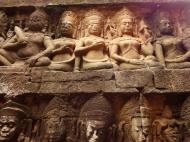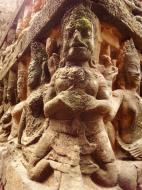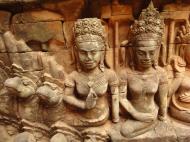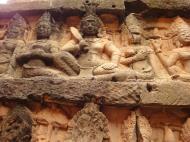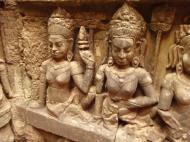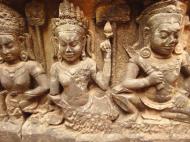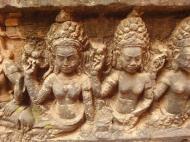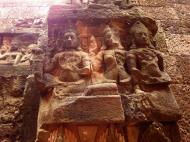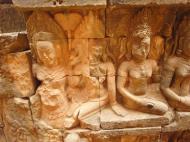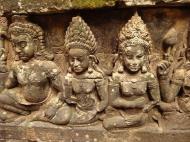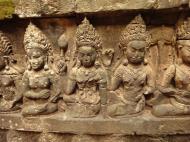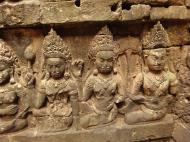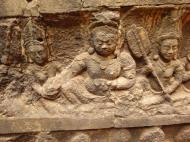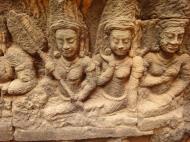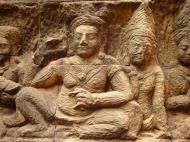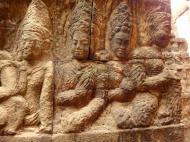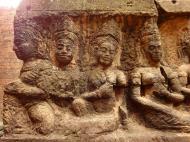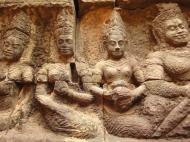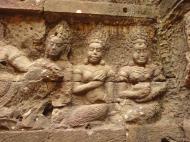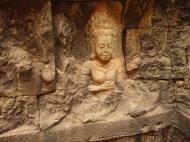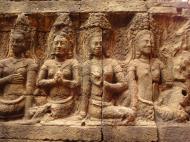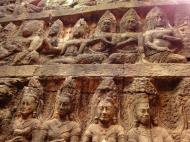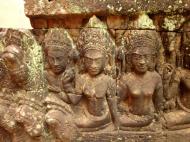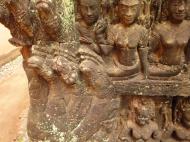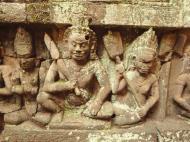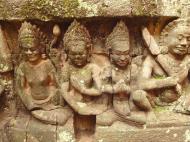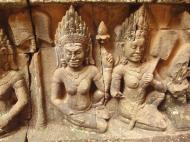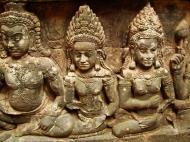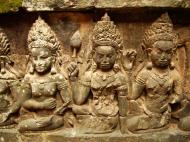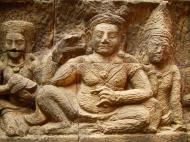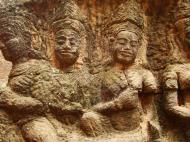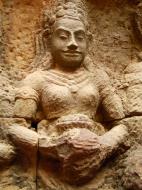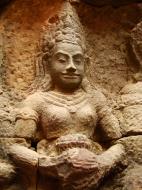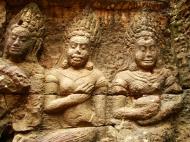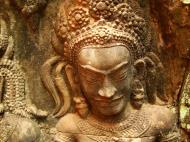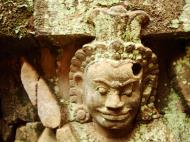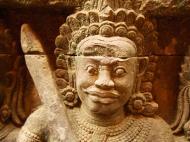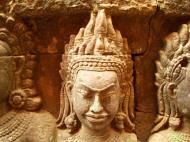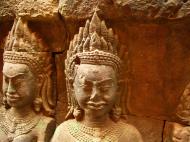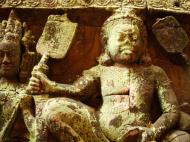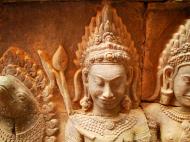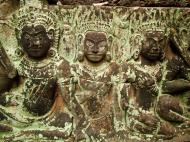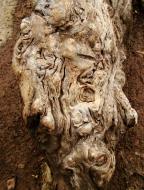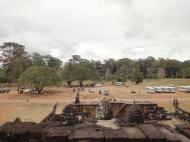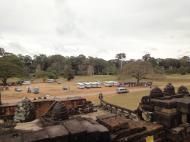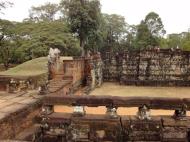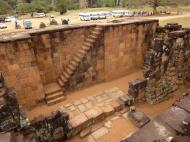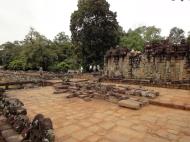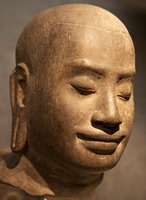Terrace of the Elephants
Name: Terrace of the Elephants
Built at the beginning of the 13th century
the terrace was part of the border of Jayavarman VII royal palace, which reached 350 m of length.
The elephants sculptured on a part of walls (recently restored) gave their name to the place.The Terrace of the Elephants is part of the walled city of Angkor Thom, a ruined temple complex in Cambodia. The terrace was used by Angkor's king Jayavarman VII as a platform from which to view his victorious returning army. Most of what remains are the foundation platforms of the complex. The terrace is named for the carvings of elephants on its eastern face.
The 350m-long Terrace of Elephants was used as a giant reviewing stand for public ceremonies and served as a base for the king's grand audience hall. The middle section of the retaining wall is decorated with life size Garuda and lions; towards either end are the two parts of the famous parade of elephants complete with their Khmer mahouts.
Terrace of the Leper King
Bayon Style (1243-1431): Following the period of frantic construction under Jayavarman VII, Angkorian architecture entered the period of its decline.
The 13th century Terrace of the Leper King is known for its dynamic relief sculptures of demon kings, dancers, and nagas. The Terrace of the Leper King (or Leper King Terrace) (Preah Learn Sdech Kunlung) is located in the northwest corner of the Royal Square of Angkor Thom, Cambodia. He was called the Leper King because discoloration and moss growing on the original statue was reminiscent of a person with leprosy, and also because it fit in with a Cambodian legend of an Angkorian king who had leprosy. The name that the Cambodians know him by is Dharmaraja, as this is what was etched at the bottom of the original statue.
The Garuda
The Garuda (Sanskrit: Garuda ????, eagle; Pali Garuda) is a large mythical bird or bird-like creature that appears in both Hindu and Buddhist mythology. Garuda is the Hindu name for the constellation Aquila and the Brahminy kite is considered to be the contemporary representation of Garuda. Garuda is depicted as having the golden body of a strong man with a white face, red wings, and an eagle's beak and with a crown on his head. The ancient deity was said to be massive, large enough to block out the sun.
Various names have been attributed to Garuda - Chirada, Gaganeshvara, Kamayusha, Kashyapi, Khageshvara, Nagantaka, Sitanana, Sudhahara, Suparna, Tarkshya, Vainateya, Vishnuratha and others.
The Vedas provide the earliest reference of Garuda, though by the name of Syena, where this mighty bird is said to have brought nectar to earth from heaven.
The Puranas, which came into existence much later, mention Garuda as doing the same thing, which indicates that Syena (Sanskrit for Eagle) and Garuda are the same. Worship of Garuda is believed to remove the effects of poisons from one's body. In the Bhagavad-Gita (Ch.10, Verse 30), in the middle of the battlefield Kurukshetra, Krishna explaining his omnipresence, says - Of birds, I am the son of Vinata (Garuda) indicating the importance of Garuda. Garuda plays an important role in Krishna Avatar in which Krishna and Satyabhama ride on Garuda to kill Narakasura.
On another occasion, Lord Hari rides on Garuda to save the devotee Elephant Gajendra. According to the epic, when Garuda first burst forth from his egg, he appeared as a raging inferno equal to the cosmic conflagration that consumes the world at the end of every age.
Frightened, the gods begged him for mercy. Garuda, hearing their plea, reduced himself in size and energy. One day, Vinata entered into and lost a foolish bet, as a result of which she became enslaved to her sister. Resolving to release his mother from this state of bondage, Garuda approached the serpents and asked them what it would take to purchase her freedom. Their reply was that Garuda would have to bring them the elixir of immortality, also called amrita. The amrita at that time found itself in the possession of the gods, who guarded it jealously, since it was the source of their immortality. They had ringed the elixir with a massive fire that covered the sky. They had blocked the way to the elixir with a fierce mechanical contraption of sharp rotating blades. They had stationed two gigantic poisonous snakes next to the elixir as deadly guardians.
Garuda hastened toward the abode of the gods intent on robbing them of their treasure.
Knowing of his design, the gods met him in full battle-array. Garuda defeated the entire host and scattered them in all directions. Taking the water of many rivers into his mouth, he extinguished the protective fire the gods had thrown up. Reducing his size, he crept past the rotating blades of their murderous machine. He mangled the two gigantic serpents they had posted as guards. Taking the elixir into his mouth without swallowing it, he launched again into the air and headed toward the eagerly waiting serpents.
Vishnu promised Garuda the gift of immortality even without drinking from the elixir, and Garuda promised to become Vishnu's mount. Flying onward, he met Indra the god of the sky. Garuda promised that once he had delivered the elixir fulfilling the request of the serpents, he would make it possible for Indra to regain possession of the elixir and to take it back to the gods. Indra in turn promised Garuda the serpents as food.
At long last, Garuda alighted in front of the waiting serpents. Placing the elixir on the grass, and thereby liberating his mother Vinata from her servitude, he urged the serpents to perform their religious ablutions before consuming it. From the day onward, Garuda was the ally of the gods and the trusty mount of Vishnu, as well as the implacable enemy of snakes, upon whom he preyed at every opportunity. Also according to the Mahabharata, Garuda had six sons from whom were descended the race of birds. The members of the race were of great might and without compassion, subsisting as they did on their relatives the snakes. Throughout the Mahabharata, Garuda is invoked as a symbol of impetuous violent force, of speed, and of martial prowess.
Powerful warriors advancing rapidly on doomed foes are likened to Garuda swooping down on a serpent. Defeated warriors are like snakes beaten down by Garuda.
The field marshall Drona uses a military formation named after Garuda. Krishna even carries the image of Garuda on his banner.
Another name for the garuda is supar?a (Pali: supanna), meaning well-winged, having good wings.
The exact size of the garuda is uncertain, but its wings are said to have a span of many miles. The garudas have kings and cities, and at least some of them have the magical power of changing into human form when they wish to have dealings with people. On some occasions garuda kings have had romances with human women in this form. The garudas are enemies to the Nagas, a race of intelligent serpent- or dragon-like beings, whom they hunt. The garudas at one time caught the nagas by seizing them by their heads; but the nagas learned that by swallowing large stones, they could make themselves too heavy to be carried by the garudas, wearing them out and killing them from exhaustion.
The secret was divulged to one of the garudas by the ascetic Karambiya, who taught him how to seize a naga by the tail and force him to vomit up his stone (Pandara Jataka, J.518). The garudas were among the beings appointed by Sakra to guard Mount Sumeru and the Trayastri?sa. In the Mahasamyatta Sutta, the Buddha is shown making temporary peace between the Nagas and the garudas.
Thai the word for a garuda is Krut (????).
In Burmese, garudas are called ga-lon.
In Kapampangan the native word for eagle is Galura.
In Japanese a garuda is called Karura (the form Garuda ????)
For the Mongols, the garuda is called Khan Garuda or Khangarid (Mongolian: ????????). Before and after each round of Mongolian wrestling, wrestlers perform the garuda ritual, a stylized imitation of the Khangarid and a hawk.
In the Qing Dynasty fiction The Story of Yue Fei (1684), Garuda sits at the head of the Buddha's throne. But when a celestial bat (an embodiment of the Aquarius constellation) farts during the Buddha's expounding of the Lotus Sutra, Garuda kills her and is exiled from paradise.
Jayavarman VII King of the Khmer Empire (c.1181-1215)
Reign: Khmer Empire: 1181-1218
Full name: Jayavarthon
Birthplace: Angkor
Died: 1218
Place of death: Angkor
Predecessor: Yasovarman II Indravarman
Successor: Indravarman II
Consort: Indradevi
Consort: Jayarachadevi (Queen's Sister)
Father: Dharanindravarman IIJayavarman VII (1125 - 1215) was a king of the Khmer Empire (c.1181-1215and was the son of King Dharanindravarman II (r. 1150-1160) and Queen Sri Jayarajacudamani. He married Jayarajadevi and then, after her death, married her sister Indradevi. The two women are commonly thought to have been a great inspiration to him, particularly in his unusual devotion to Buddhism. Only one previous Khmer king had been a Buddhist.
Jayavarman's Early Years
Jayavarman probably spent his early years away from the Khmer capital. He may have spent time among the Cham of modern-day Vietnam. In 1178, they launched a surprise attack on the Khmer capital by sailing a fleet up the Mekong River, across Lake Tonle Sap, and then up the Siem Reap River, a tributary of the Tonle Sap. The invaders pillaged the Khmer capital of Yasodharapura and put the king to death, as well as taking the Apsara dancers. Also in 1178, Jayavarman came into historical prominence by leading a Khmer army that ousted the invaders.
Returning to the capital, he found it in disorder. Early in his reign, he probably repelled another Cham attack, quelled a rebellion, and rebuilt the capital of Angkor. Over the 30 some years of his reign, Jayavarman embarked on a grand program of construction that included both public works and monuments. As a Mahayana Buddhist, his declared aim was to alleviate the suffering of his people. One inscription tells us, 'He suffered from the illnesses of his subjects more than from his own; the pain that affected men's bodies was for him a spiritual pain, and more piercing.'
The declaration must be read in light of the undeniable fact that the numerous monuments erected by must have required the labor of thousands of workers, and that Jayavarman's reign was marked by the centralization of the state and the herding of people into ever greater population centers. Historians have identified three stages in Jayavarman's building program. He constructed his own 'temple-mountain' at Bayon and developed the city of Angkor Thom around it.
Ta Prohm
In 1186, Jayavarman dedicated Ta Prohm ('Ancestor Brahma') to his mother. An inscription indicates that this massive temple at one time had 80,000 people assigned to its upkeep, including 18 high priests and 615 female dancers. The first Lara Croft film was shot in Ta Prohm as well as a few scenes from the movie Troy.
Preah Khan
Jayavarman also built the temple and administrative complex of Preah Khan ('Sacred Sword'), dedicating it to his father in 1191.
Angkor Thom and Bayon
At the centre of the new city stands one of his most massive achievements -- the temple now called the Bayon, a multi-faceted, multi-towered temple that mixes Buddhist and Hindu iconography. The reliefs show camp followers on the move with animals and oxcarts, hunters, women cooking, female traders selling to Chinese merchants, and celebrations of common footsoldiers. The reliefs also depict a naval battle on the great lake, the Tonle Sap.
Fixing the Dates
The historical record is a mixture of the incredibly precise (we know the exact date that a temple was consecrated) and more ambiguous texts and archaeological evidence. Many of the dates marking the life and reign of Jayavarman VII are a matter of conjecture and inference. There is a minority view that the current biography of Jayavarman is imaginary and that the evidence could just as easily support the view that he was the usurper.
One date that has been generally accepted is 1177 when the Chams, who had themselves been subjected to numerous Khmer invasions, took the city of Yashodharapura. A Cham king took the title of Jaya-Indravarman.
In 1181 Jayavarman VII became King after leading the Khmer forces against the Chams. Jayavarman died in about 1215, at an advanced age ranging from 85 to 90. Indravarman was succeeded by Jayavarman VIII who it is thought supported a Hindu revolt. The niches all along the top of the wall around the city contained images of the Buddha. A statue of Jayavarman VII was found by excavators having been thrown down a well. Buddha images in Preah Khan were re-worked to resemble Brahmins. When Cambodia finally did become a Buddhist country, it followed Theravada Buddhism, not the Mahayana Buddhism practised by Jayavarman VII.
Interpretation
Care must be taken not read European patterns of kingship, inheritance or nationhood onto the history of the Khmer empire. Sons did not necessarily inherit their father's thrones; Jayavarman VII himself had many sons, such as Suryakumara and Virakumara, who were crown princes (the suffix kumara usually is translated as crown prince).
Jayavarman VII remains a potent symbol of national pride for present day Cambodians. This has contributed to a legend of the Buddharaja, the King-Buddha, who privileged compassion in ruling. This view of Jayavarman and his reign is supported by some beautiful portrait sculpture of him in meditation.
References
A fictionalised account of the life of Jayavarman VII forms the basis of Geoff Ryman's 2006 novel ‘The King's Last Song’.
Statue of Jayavarman VII, Guimet Museum http://en.wikipedia.org/wiki/File:JayavarmanVII.jpg
Terrace of the Elephants, Siem Reap, Cambodia Map
 Editor for Asisbiz: Matthew Laird Acred
Editor for Asisbiz: Matthew Laird Acred
If you love our website please add a like on facebook
Please donate so we can make this site even better !!
